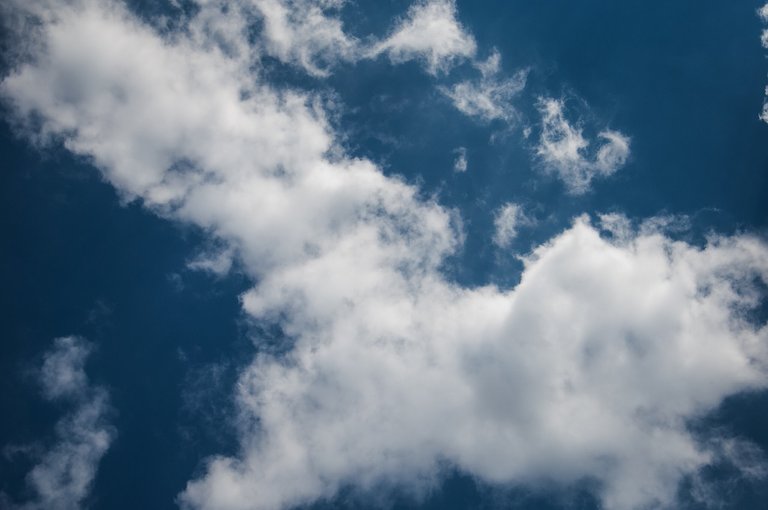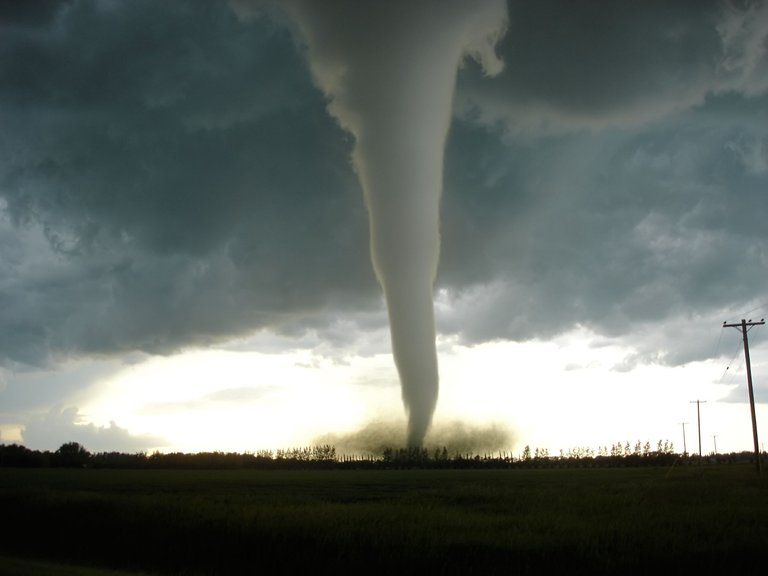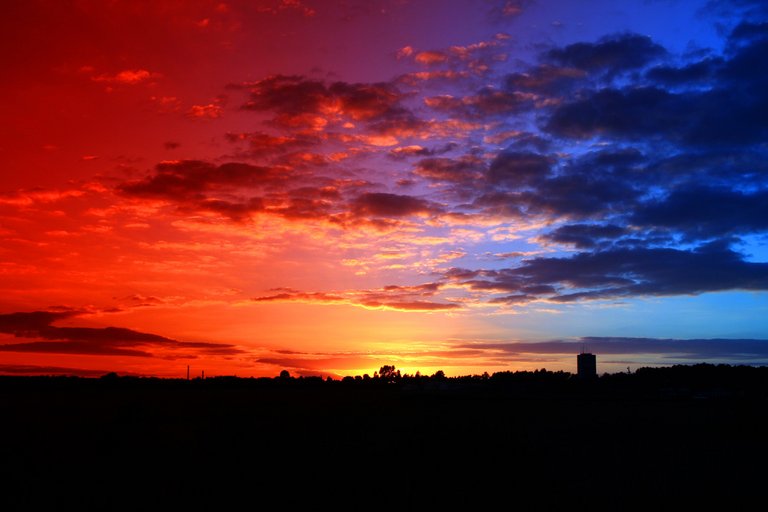When you hear the phrase 'involuntary actions' what comes to your mind first? Breathing? Blinking of the eye? Sneezing? Maybe if you are like a friend of mine you might want to say farting. That’s probably because of his nature of always releasing farts. Hmmm, very awkward. Breathing as we know is something we just find ourselves doing, without basic control. We do however know that when we breathe, we take in air and release carbon dioxide. But, what is that AIR and how versatile can it be?
Cloud formation in the atmosphere . From pixabay.com
Writing about air is somewhat uneasy, because of its complexity and volume, but I will majorly talk about interesting stuffs, like have you ever imagined what would have happened if air was a conductor of electricity? Do you know that air is not just made up of oxygen? That oxygen in fact is not the major composition of air? Do you know what a contrail is? What about tornadoes, how are they formed? Mirage? Do you know what it is? Well maybe you do. But let’s take a look at this interesting provision of nature.
AIR
Maybe you have heard about the “four classical element”, Air, water, fire and earth (in no particular order). Air is a gaseous matter that surrounds us and makes up the atmosphere. It is the gas that sustains life. It however is not all oxygen.
Air is a mixture of 78% Nitrogen, 21% Oxygen, and the remaining 1% goes to other gases, including carbon dioxide.
Air is matter and as such it has weight and occupies space. It can be measured. It can be compressed. We will take a dive into its amazing properties.
As amazing as air proves to be, it can only be found on and around earth, and nowhere else, if you doubt that maybe you need to contact Neil Armstrong to confirm that. The air found around the earth is what we refer to as the atmosphere, which can be further subdivided into layers.
These layers are all important and not a single one of them is dispensable, but their roles are different. One of which is to protect the earth from falling debris and harmful radiations from the space.
It becomes necessary to take a look at some amazing things about Air.
AIR and Breathing
Earlier I mentioned that in the process of breathing, we take in air and release carbon dioxide. Some people will prefer to put it as taking in oxygen and releasing carbon dioxide. Which is correct? Well both are. The latter is often used because oxygen is what we need to survive, but of course air is not all oxygen, so how do we do the remaining 79% or air that isn't oxygen.
THE LUNGS
The lungs are a vital part of our body. It does amazing work for us in the background. Take a look at what it does. The air we breathe in goes to our lungs through the trachea, and there in the lungs are small air sacs, within this air sacs, the concentration of oxygen is high enough to diffuse through small pores called the aveolar membrane into the pulmonary capillary. The haemoglobin on the other hand has high affinity for oxygen but has carbon dioxide bound to it, but at the pulmonary capillary, the oxygen binds with haemoglobin to displace the carbon dioxide in the blood. Then the oxygenated blood flows to the heart, so as to be pumped to other parts of the body!
This process is quite amazing because it all occurs in a fraction of a second. More amazing is the fact that we are not quite aware of this, it sort of happens automatically. For a more descriptive explanation, watch this free video on YouTube.
Note: We need to be careful to avoid inhaling too much of carbon monoxide (CO) into our system. Haemoglobin has affinity for oxygen, but has higher affinity for carbon monoxide and will absorb it into the bloodstream. CO exist in an unstable state and would want to combine with available oxygen to make CO2. In very little time the little oxygen present in your blood will be kidnapped by carbon monoxide and fresh oxygen won't be coming in. Death is imminent!
AIR - A conductor or an Insulator
If you were asked to choose conductor or insulator to describe a property of air, what would it be? How would you answer to that. Like me some years back you may be tempted to say conductor, but think about this. Very high voltage transmission lines travel in our environment, practically through air, right. Would we not get electrocuted if air was a conductor? Oh it is an insulator you are likely to say. Well that would be correct but not totally correct.
A material is an insulator as long as the breakdown voltage is more than the applied voltage. Maybe that's some grammar. Imagine you put a 240 volt live wire on a wooden bench and you touch the bench from another point, you won't feel the electricity. Because dry wood is a good insulator, right. Now apply 330,000 Volts of electricity to the same bench and attempt to touch the bench, your imagination, I suppose would prevent you from trying that.
What's the point? Dry air is a good insulator, but could also become a conductor depending on the level of electricity it is exposed to. But don't get scared, air to a large extent is an insulator.
AIR and Light Dispersion
Here is phenomenon we are quite familiar with. In the afternoon you look up into the sky and the sky is blue, but at sunset, the sky has this reddish gold color. Familiar, right? How is this even possible? Does the sun change color? No! Let’s take a look at the air and the atmosphere.
The great Isaac newton helped us discover that in a white light there exist about seven colors and they can be seen if the light is dispersed. When the light is made to pass through certain medium, like a glass prism, we can visibly see the colors contained in the light. Also if the light is made to pass through a clear fluid like water and air, dispersion takes place.
These colors is what we refer to as the color spectrum. They are: Red; Orange; Green; Blue; Indigo; Violet. They have different wavelength ranging from 720nm in red to 380 nm in violet. On a clear and cloudless day, in the afternoon the sun is perceived to be directly on top of us and the molecules or air scatter blue light more than any other color, which makes the sky blue. Then at sunset, the rays of light passes through more layers of air and the blue light must have been scattered away due to its smaller wavelength, while red or orange color travels farther and the sky is painted in that scarlet gold color.
More beautiful is the color seen over the ocean at sunset or sunrise. It is redder than other places, and this is due to the presence of salt in the air around that area, which also shows that the nature of particles present in the air will also affect the color which is scattered from the light ray. This principle is what guides the formation of rainbow, but we will leave that explanation to another time as the scope of this article covers air-related phenomenon.
AIR – The mirage formation
Here is another phenomenon. You are traveling on a sunny day, probably driving or being driven, doesn’t matter which, you look ahead at about a hundred yards out and you see something that looks like water or a body of water, or sometimes might even look like oil spillage. You ask and all you were told was that it is called a mirage. What is a mirage? How is it formed? What does air has to do with mirage formation?
First, a mirage is an image of something that is not real. An image perceived to be present when in true sense it is not there. Mirage is formed when light rays are diffracted especially when it is travelling from one medium to another. Light is diffracted and also reflected at the boundary of two different medium. This means that when light travels from air to glass or water at the boundary of this medium we experience reflection and diffraction of light rays. This can form mirage.
On a sunny day, however, light rays only travels through air, and yet mirage is formed. The sun heats the roadway, then the roadway heats the air around it. That makes sense right? Now when air is heated, or when the temperature of air is increased the density of the air is reduced, the air becomes thinner. This means that the air around the roadway is less dense than the atmospheric air. So when light passes through the air on a sunny day from a more dense air to a less dense air, it is said to be moving through a non-uniform medium, and as such a mirage is formed. Basically the difference in air density and the angle at which you look at the road makes a perfect condition for mirage formation.
AIR and Contrail Formation
Contrail. That may sound like another grammar. Take a chill pill.
When I was growing up, I remember that when an airplane is traveling and happens to emit some white and thick substance, and leaves a trail behind, we believe it has come to deliver cassava flour, and so we sing a rather funny song to eulogize the airplane. But we alongside our rather primitive society did little to understand what it was and why it appears on occasion.
Contrails are trails formed from the condensation of engine exhaust. When Jets travel at high altitude where the vapor pressure and temperature is quite low, and the jet emits hot air from its exhaust, then a contrail is formed. The higher the altitude the less oxygen contained in the air. The amount of water vapor in the air increases and the atmospheric pressure drops very drastically. One reason why mountain climbers go with oxygen canisters.
Basically, the contrails are a result of precipitation of air vapor in the jets exhaust caused by its mixture with very cold air in the atmosphere at that altitude. Very proficient and experienced pilots with a jet fighters can actually produce very beautiful shapes to behold in the sky by harnessing this beautiful phenomenon.
AIR and Rain
Have you ever been told that rain drops is as a result of angels urinating in the heavens, or that there’s an ocean of water that pours to form rain? Maybe not, but if you grow up the way I did, superstitious beliefs like this would not be strange. Big thanks to science, we are able to debunk these fictitious stories. So for the sake of reminder for those aware or knowledge for those ignorant, let us look at how rain is formed, and what air has to do with rain formation.
Generally the water cycle has it that the sun evaporates water from the ground and from water bodies and they turn to vapor and eventually precipitates and come back as rain. But what happens in the air? How does the water gets to stay as vapor?
When the water vapor gets to the atmosphere, warm air makes it condense and the condensed vapor clings to dust particles present in the atmosphere to form cloud. This principle is easier understood when brought home on relatable terms. If you are in your car on a cool rain day, you notice that warm air coming from your breath will precipitate on the windshield of your car. But if you turn the A/C on the vapor will clear off.
The air wind is responsible for keeping the clouds afloat, and also to shift the clouds over distances. But when the clouds join together and become heavy, then they are likely to precipitate as rain droplets, or when the temperature of the air drops significantly, just like when you turn the A/C on, the cloud precipitates in rain droplets.
AIR and Tornadoes
If you are from Africa, you may not fully understand what tornadoes are, due to lack of experience, you may want to ask someone who lives in Texas! Maybe all your contact with that word will be when a carpenter mentions a type of nail, tornado nail. Luckily, if you happen to watch a lot of movies like me, maybe you could have seen into the storms and would understand what a tornado is. Or if you are like @addempsea, who watch a lot of YouTube videos, then you probably would have seen enough of tornadoes.
A fully formed tornado. Wikimedia commons under the CC 3.0 license. Author : Justin Hobson.

A tornado is a violent and rapidly rotating column of air that is in contact with both the surface of the Earth and the cloud. - Wiz kid weather information for kids
The picture above shows a tornado. But, how is it formed?
There are about four stages to its formation and they all relate to air. A thunderstorm is what is first formed. Warm moisture rising from the earth is pushed upward by cold air, and then condenses to form clouds. Then the winds that increase rapidly in strength and height causes the uplifting moisture to rotate, then what we call a super cell is formed. The warm air below too begins to rotate due to the winds and then the surrounding air tries to balance the uplift only to be sucked up to make the storm stronger till a vacuum is formed where it can lift virtually anything.
Tornado has a lot of force and can reach up to 400mph. It is very destructive but starts with air. What a powerful element air is!
You may wonder what differentiates the tornado from the hurricane, I'd discuss that in the next article!
Conclusion
These amazing phenomena in this article shows how versatile air is. What an awesome gift we have in nature.
Air is matter. It can be quantified either by weight or by volume. Its properties and nature makes it something we can’t do without. Its usefulness can vary based on what state air is: dry air; wet air; warm air; cool air.
Air is one of the four classical element, my next three articles will be taking an integral look at each of the remaining three elements, namely, fire, water, and earth.
References
characteristic of air as an insulator
If you write STEM (Science, Technology, Engineering, and Mathematics) related posts, consider joining #steemSTEM on steemit chat or discord here. If you are from Nigeria, you may want to include the #stemng tag in your post. You can visit this blog
You can also join us at Promo-Mentors, to improve your blogging skills. Join our discord channel and meet awesome mentors who are willing and ready to shape your writing skills.

.svg.png)



Morning wood. 😌😌
Don't be a racist, we have the internet, we can read and watch YouTube videos of tornadoes.
All in all, this is a very brilliant post. You should write more often, I certainly enjoy reading your articles. Keep up the good work.
I really do not mean to sound like that, have you experienced tornado before?
An old African adage says that a scar can't be compared to the undamaged body.
Regardless I think I'd rephrase! Thanks.
Wow.... This is so informative.
Sometimes I can't help but wonder why childhood as an African was such a scam.
Imagine the airplane scenario. Nice one Sir
You know the song?
Haha, why not?
Aeroplane ton lö
Bami ki Iya elekö kan...
Ëkö meji to fun mi
O yo mi...
I'm sure you're familiar already.... ☺
Of course 😅😅😅
Please beg me to stop clapping as I'm wowed by the quality of your creativity. Nature has been designed to present various phenomenon to us. You just took me through one of such - What an interesting read I must say. The versatility of air is indeed incomparable.
Kudos man!
Thanks. Am flattered
My pleasure man.
Airplane delivering cassava flour? Lol. Funny childhood memory
This is a very impressive and detailed post. As usual, You had me glued all through and I agree with @addempsea. You should write more often Air is truly a versatile element
I'll try to write more often. Thanks
Air is life.. Let me just put it that way.
You did a great job by telling us so many good things about air.
Thanks baba
Congratulations! Your post has been selected as a daily Steemit truffle! It is listed on rank 4 of all contributions awarded today. You can find the TOP DAILY TRUFFLE PICKS HERE.
I upvoted your contribution because to my mind your post is at least 33 SBD worth and should receive 158 votes. It's now up to the lovely Steemit community to make this come true.
I am
TrufflePig, an Artificial Intelligence Bot that helps minnows and content curators using Machine Learning. If you are curious how I select content, you can find an explanation here!Have a nice day and sincerely yours,

TrufflePigtruly AIR reshapes the world.
im begining to wonder what we can do without air.
is there?
Can the body even do without when H is added to the word.? Nevertheless the air itself.. Lolz
all i have to say is AIR is everything we live on/for.. Even before the creation of the earth by God, air has existed that shows how important and essential it is for man. keep the flag up bro
This is an 'Air-aided' post. I was breathing so slow cos I related well with it. I didn't want it to end. I've had some things change and I have also learnt some new things too.
You are a 'proud' writer. 🙌
Thanks man! I appreciate the time you took to read it.
Wow! Am I still reading about the air I know? (Maybe, used to know). This has really changed many stories I've been fed
Contrails! - this is newly learnt. Thanks friend
Write on...
Thanks friend! I'll keep writing and learning. I watched a documentary some years back when I saw first time what a contrail is and how good pilots use it to decorate the sky!
Nice. That is the power of Knowledege...Never stop learning...